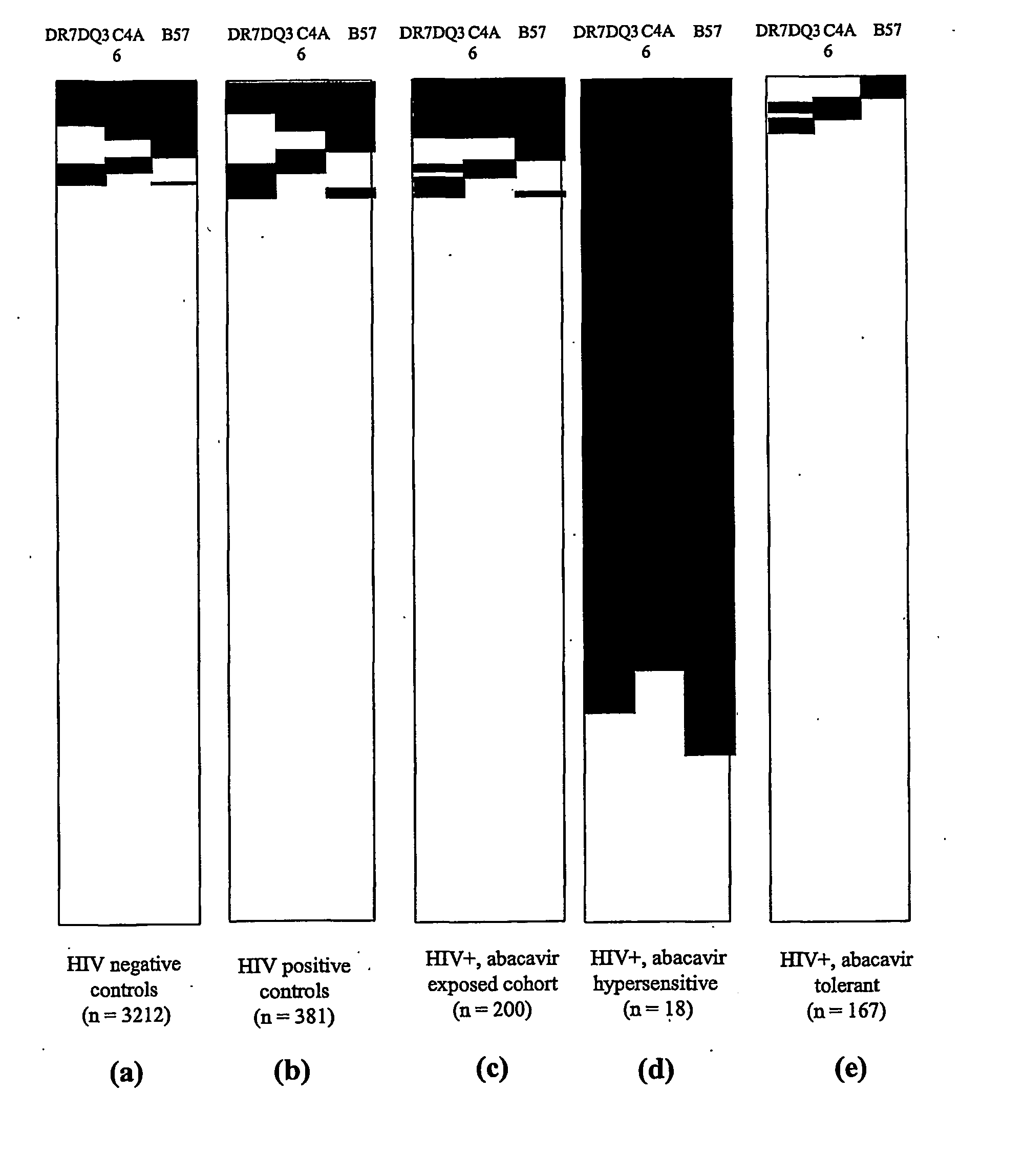Method for identification and determination of hypersensitivity of a patient to abacavir
a technology of abacavir and hypersensitivity, applied in the field of patient identification, can solve the problems of recurrence of symptoms, range of ailments, individuals who are hypersensitive to some of these inhibitors,
- Summary
- Abstract
- Description
- Claims
- Application Information
AI Technical Summary
Benefits of technology
Problems solved by technology
Method used
Image
Examples
example 1
[0044] Subjects: Five hundred and eighty one active participants in the Western Australian HIV Cohort Study on 31 Dec. 2001 were considered. These patients were HLA typed at HLA-A, -B, -C, -DR and -DQ at enrolment into the cohort study and followed-up at one to three monthly intervals. A clinician actively collected details of the anti-retroviral treatment history and adverse drug reactions at each visit. This included a specific question to record any history of possible hypersensitivity to abacavir. The first 200 participants of the cohort prescribed abacavir to 31 Dec. 2001 were included in the study, with abacavir prescription validated in all cohort cases through the use of the Royal Perth Hospital pharmacy database. The medical records of abacavir-exposed individuals were reviewed by a single clinician blinded to HLA typing results for evidence of abacavir hypersensitivity, utilising standardised diagnostic criteria: [0045] Onset of at least two of the following symptoms withi...
example 2
Refined Mapping of Genetic Susceptibility to Abacavir Hypersensitivity
[0066] Summary: As described above, a region of approximately 300 kb between C4A6 and D6S273*135 (MEGT1) was identified as a region likely to carry the gene(s) contributing to abacavir hypersensitivity. In addition, a number of other idiosyncratic drug reactions have been shown to involve MHC-restricted presentation of the drug or its reactive metabolite after peptide haptenation or direct covalent or non-covalent binding of the drug to HLA molecules. Therefore, the inventors examined the association of MHC alleles within the 300 kb interval bound by C4A6 and the D6S273*135 microsatellite allele in a restricted patient set recombinant for the 57.1 AH. Gene(s) likely to initiate the hypersensitive response independently or through HLA-B5701 restricted presentation to the immune system were examined.
[0067] Further mapping as described below narrowed the susceptibility region to a 40 kb region bounded by Neu1 and 7...
example 3
Testing of SNPs to Determine the Best Test for ABC HSR
[0088] Screening of the two population studies (200 in retrospective study [Mallal et al (2002) Lancet, 359:727-732] and 49 in the prospective study) using our stored DNA on patients who were either sensitive or tolerant to abacavir, was performed to validate the test and to determine the sensitivity, specificity, positive and negative predictive values.
[0089] More specifically, the sensitivity, specificity, positive and negative predictive values of the SNP combinations were carried out as done for HLA-B*5701 and HLA-B*5701+DR7+DQ3 (the entire 57.1 haplotype) as described in Example 1 and Mallal et al (2002) Lancet, 359:727-732. The test with the highest positive and negative predictive values is the most useful and therefore the most preferred.
SNP Mining
[0090] The SNPs carried on the 57.1AH identified by sequence comparison of the 8.1, 7.1 and 18.1 Ahs were examined using pyrosequencing SNP assay.
Specific Amplification ...
PUM
| Property | Measurement | Unit |
|---|---|---|
| Digital information | aaaaa | aaaaa |
| Volume | aaaaa | aaaaa |
| Molar density | aaaaa | aaaaa |
Abstract
Description
Claims
Application Information
 Login to View More
Login to View More - R&D
- Intellectual Property
- Life Sciences
- Materials
- Tech Scout
- Unparalleled Data Quality
- Higher Quality Content
- 60% Fewer Hallucinations
Browse by: Latest US Patents, China's latest patents, Technical Efficacy Thesaurus, Application Domain, Technology Topic, Popular Technical Reports.
© 2025 PatSnap. All rights reserved.Legal|Privacy policy|Modern Slavery Act Transparency Statement|Sitemap|About US| Contact US: help@patsnap.com



